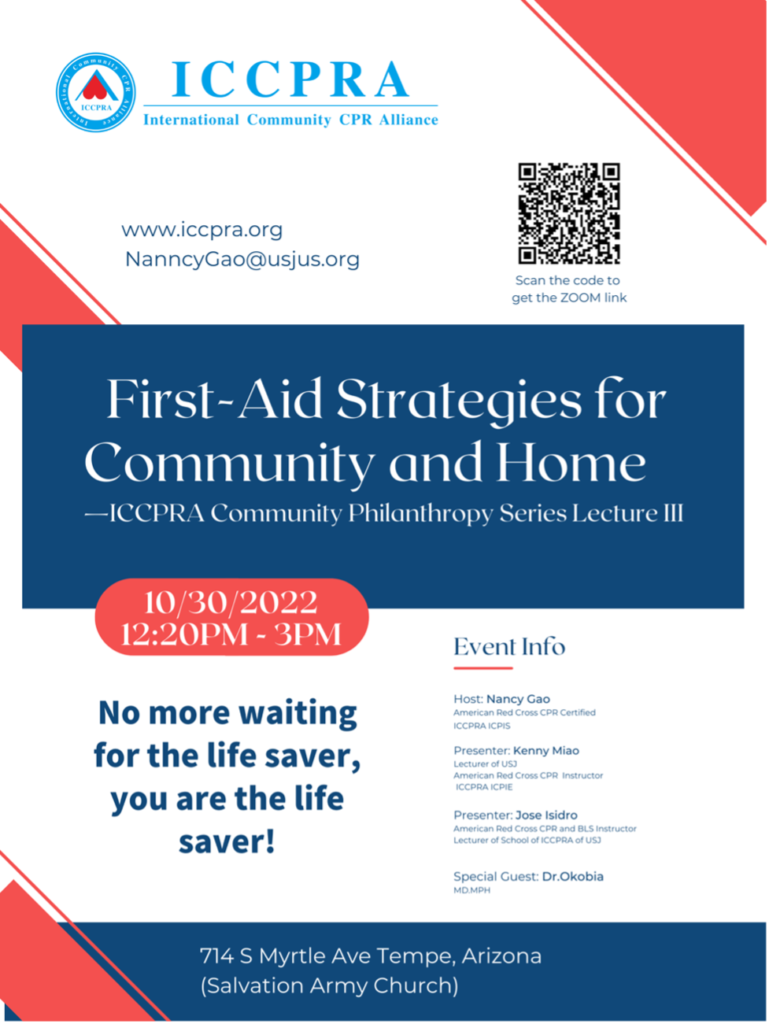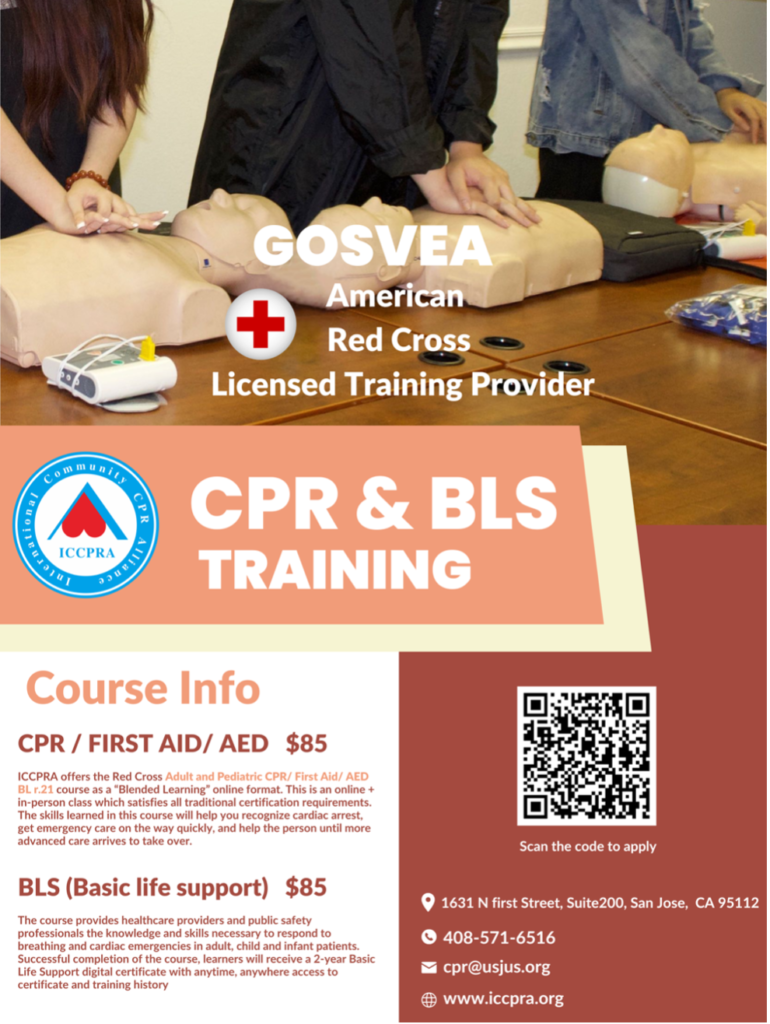
A Must-Learn Course for Parents in the US
One Minute First-Aid, Lifetime Happiness.
Case – a baby lost breathing
In the United States, hospitals usually require new parents to participate in the “Infant/Child First-Aid, CPR, AED Training Course”. In September 2022, a parking lot monitor in Lee County, Florida recorded a thrilling scene: a mother was in the parent pick-up line and noticed that her baby in the backseat wasn’t breathing and was unresponsive. She exited her car and frantically called for help. Fortunately, Deputy Weaver, a school resource officer, was working at the time. He calmly picked up the child and started back thrusts and chest compressions. This ultimately brought back the baby’s breathing and saved the baby’s life.

Image Source:Lee county sheriff’s office
Every younger parent must know the CPR for your Kids
CPR training is not only a Must-Learn course for parents. In public elementary schools, teachers must renew their CPR certificates every two years, for them to become the most reliable savior (FIRST first responders) for the children.
Jose Isidro, a senior CPR Instructor of ICCPRA with 30 years of experience, once shared: he sometimes will ask the class to talk about their childhood accidents. Surprisingly, nine out of ten have experienced accidental injuries in childhood, which shows the importance of CPR training!
Our ICCPRA instructors keep on teaching first aid and CPR skills to our members and local communities for many years. Although the “Infant/Child First Aid and CPR Course” is about three hours long, today it only takes 3 minutes for you to learn the most vital knowledge. Don’t miss this.
What is CPR
Cardiopulmonary resuscitation is a combination of chest compressions and breath-giving. If someone suffers cardiac or respiratory arrest, CPR can circulate oxygenated blood into the brain to keep the brain oxygenated.
CPR is necessary for many emergencies, including traffic accidents, drowning, asphyxiation, poisoning, smoke inhalation, electrocution injuries, and sudden infant death syndrome (SIDS) (source: Mayo Clinic). There are three types of CPR, infants (under 1 year old), children (1 – 8 years old), and adults (over 8 years old). Today we are going to share the Infant CPR technic.
Giving CPR to Infant
(American Red Cross)
1) CHECK the scene for safety, form an initial impression, obtain consent from the parent or guardian and use PPE.
2) If the infant appears unresponsive, CHECK for responsiveness, breathing, life-threatening bleeding or other life-threatening conditions using shout-tap-shout.

Image Source: American Red Cross
3) If the infant does not respond and is not breathing or only gasping, CALL 9-1-1 and get equipment, or tell someone to do so.

Image Source: American Red Cross
4) Place the infant on their back on a firm, flat surface.
5) Give 30 chest compressions.
- Hand position: Thumbs (side-by-side) on the center of the infant’s chest, just below the nipple line; other fingers encircle the infant’s chest toward the back, providing support
- Body position: Stand or kneel to the side of the infant;
- hips at a slight angle
- Depth: About 11/2 inches
- Rate: 100 to 120 per minute
- Allow chest to return to normal position after each compression

Image Source: American Red Cross
6) Give 2 breaths.
- Open the airway to a neutral position using the head-tilt/chin-lift technique
- Ensure each breath lasts about 1 second and makes the chest begin to rise; allow the air to exit before giving the next breath
- Note: If the 1st breath does not cause the chest to rise, retile the head and ensure a proper seal before giving the 2nd breath If the 2nd breath does not make the chest rise, an object may be blocking the airway

Image Source: American Red Cross
7 )Continue giving sets of 30 chest compressions and 2 breaths. Use an AED as soon as one is available!
Caring for Infant Choking
(American Red Cross)
- Complete the CHECK step and verify the infant is choking.
Note: If the infant can cry or cough forcefully, encourage them to keep coughing. Observe and prepare to act if their condition changes.
- If the infant is unable to cry or cough, CALL 9-1-1 and get equipment, or tell someone to do so.
- Give 5 back blows.
- Hold the infant in a face-down position along your forearm using your thigh for support. Keep the infant’s head lower than their body.
- Give 5 firm back blows, with each one separate from the others. Keep your fingers up to avoid hitting the infant’s head or neck.

Image Source: American Red Cross
- Give 5 chest thrusts.
- Turn the infant face-up (support their head and neck) and lower them onto your thigh. Keep the infant’s head lower than their chest.
- Give 5 quick chest thrusts about 11/2 inches deep with two fingers in the center of the infant’s chest. Each chest thrust should be separate from the others.

Image Source: American Red Cross
- Continue giving sets of 5 back blows and 5 chest thrusts until:
- The infant can cough forcefully or cry.
- The infant becomes unresponsive.
- Note: If the infant becomes unresponsive, gently lower them to a firm, flat surface and begin CPR, starting with compressions. After each set of compressions and before attempting breaths, open the infant’s mouth, look for the object and, if seen, remove it with a pinky sweep.

Image Source: American Red Cross
Remember these important and useful skills, you may save a child’s life in a crisis. Of course, we hope that you will never need to use these, after all, safety and health are more important than anything else. ICCPRA sincerely wishes you healthy life with lots of happiness, love, joy, laughter, and smiles!
Simple Choice in ICCPRA, Huge Impact in Your Community.
More CPR Knowledge at www.iccpra.org, Join us today and together we can save lives. One minute First-Aid, you will be the lifesaver.
Contact Information:
Joanna Wang
Tel: 530-761-6289 408-571-6516
Joannawang@usjus.org


